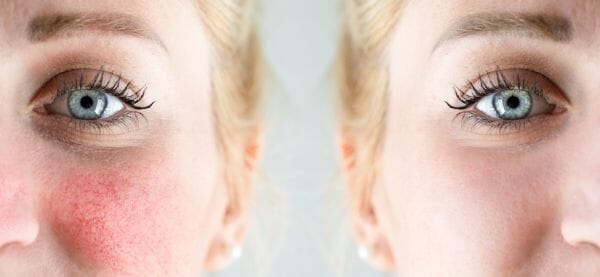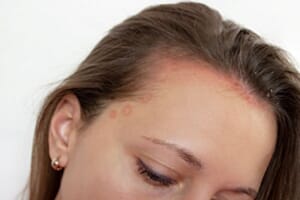Rosacea is a condition that is caused by dilation of blood cells below the skin’s surface caused by an underlying inflammatory response. The dilation of the blood cells causes the typical flushing associated with rosacea and eventually leads to leaking capillaries (thread veins).
An estimated 415 million people worldwide have rosacea, which is about 5.46% of the global adult population.
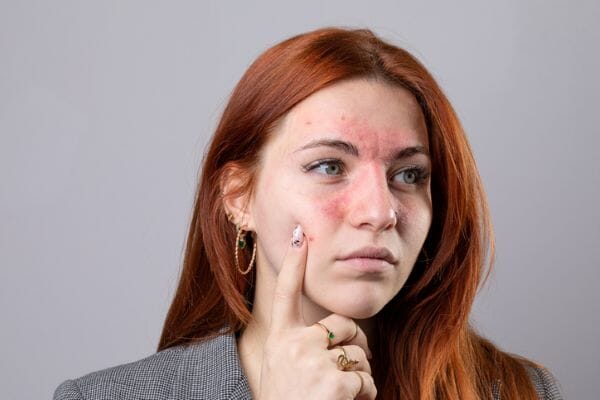
The inflammatory response elements known to be responsible for rosacea triggers has led researchers to link it to several other inflammatory health conditions.
What’s not clear is whether a genetic predisposition to rosacea is the primary link to other inflammatory health conditions or that other inflammatory health conditions are what triggers rosacea as a secondary condition.
Dermatologist Dr Eva Melegh says. “If you suffer from one of the following seven health conditions and also find you’re getting frequently flushed and bumpy red skin, thread veins and cycles of small itchy pustules on the cheeks and nose area, it’s likely you may also have rosacea.”
Hay fever
Rosacea of the skin can also occur in the eyes and manifests as red, burning and watery eyes. Hay fever symptoms can appear similar to those of ocular rosacea.
“Ocular rosacea that does not have other symptoms of rosacea is often misdiagnosed as allergies or hay fever. Yet in about 20% of people with rosacea, ocular signs are the first indication of the condition,” says Dr Melegh.

To make diagnosis even more problematic, allergies such as hay fever can also be a trigger for rosacea flares.
“People who suffer from hay fever or allergies are more likely to also suffer from rosacea as well. The two conditions are both inflammatory responses, yet they require different treatments so it’s important to get diagnosed properly,” says Dr Melegh.
Cystitis
A recent study on 65 people with rosacea at Johns Hopkins University and published in the American Academy of Dermatology identified associations between rosacea and urogenital diseases such as urinary tract infection (cystitis).

The researchers concluded that it was likely that the connection between rosacea and cystitis involves mechanisms that underlie chronic inflammatory conditions coupled with barrier skin tissue issues.
Acid Indigestion
The most common cause of acid indigestion is low stomach acid production (hypochlorhydria)and several studies have found that a significant amount of people with rosacea also have hypochlorhydria.

“Many studies have found links between rosacea and acid indigestion, which may be linked to an underlying inflammation of the stomach lining,” says Dr Melegh.
At the top of the stomach (a muscular bag) there’s a ring muscle called the lower oesophageal sphincter (LES). It opens to allow food in via the oesophagus (food pipe) and closes when the stomach is full and very acidic. The acidity is thought to be a trigger for this muscle to shut.
If the lower oesophageal sphincter is open, even a little, the food mass backs up into the oesophagus and cause a burning sensation which is known as acid reflux.
4. Anxiety-linked depression
Stomach acid (hydrochloric acid) is a strong acid which is essential for digesting food, controlling of bacteria and absorption of essential vitamins from food.
In addition, hydrochloric acid also stimulates the release of an exclusive carrier protein necessary for the transportation of vitamin B12 which is crucial for brain and nervous system function as well as the formation of red blood cells.

Studies have found that hypochlorhydria results in reduced absorption of vitamin B12 which may be why there’s a link between rosacea and symptoms of anxiety linked depression.
5. Celiac disease
Rosacea has a significant association with celiac disease (wheat intolerance)
Researchers in Denmark conducted a population-based, case-control study of 6,759 patients with rosacea.

Women with rosacea on the study were found to have a significant association with celiac disease.
“This may be due to an underlying inflammation of the stomach lining that causes sensitivity to wheat-based products,” says Dr Melegh.
6. Diabetes
Research published in the European Journal of Dermatology found a possible relationship between rosacea and insulin resistance – a metabolic disorder that may be a precursor to diabetes.
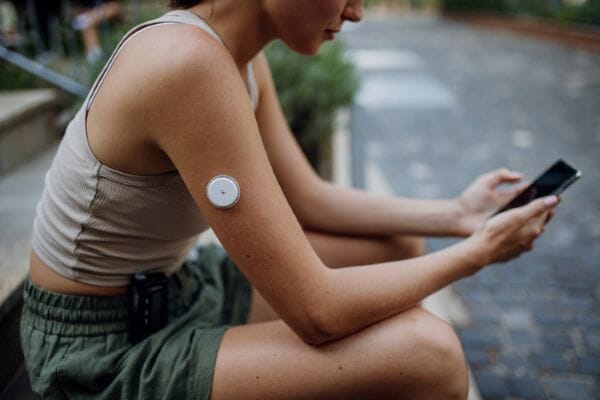
In the study insulin resistance was calculated according to a standard method that compares insulin and glucose levels in the blood. The researchers measured these physical parameters and others in 47 rosacea patients and 50 individuals without rosacea. The results found that rosacea patients were significantly more likely to have insulin resistance.
The researchers suggested that the potential association between rosacea and insulin resistance may be explained by the fact that increased inflammatory cytokines and oxidative stress occur during the pathogenesis of both rosacea and insulin resistance.
7. Arthritis
Most people don't associate skin conditions with arthritis, but in fact, the skin is also an organ affected by rheumatoid arthritis (RA).
“Autoimmune diseases such as RA can cause inflammation of the blood vessels in the skin which can be a trigger for rosacea flares,” says Dr Melegh.

Rosacea occurs more than three times more often in women than men, which is a similar ratio seen in people with RA.
A Danish study at the University of Copenhagen found a link between rosacea and autoimmune diseases including RA. The study found that women with rosacea were more than twice as likely to have a concurrent autoimmune disorder like RA than their rosacea-free counterparts.
Dr Melegh’s 5 skincare tips for managing rosacea
“There's no definitive rosacea cure as it’s a chronic rather than an acute skin condition. However, it can be managed successfully, typically with a combination of some limited medication, targeted skincare products and a regular skincare routine with certain skincare precautions,” says Dr Melegh.
1. Use dedicated skincare
Use skincare that is specifically formulated for use on skin prone to rosacea and use it between flares and not just when a flare occurs. This should ideally involve more than one product as rosacea is a skin condition with several symptoms that manifests in cycles which require a multi-tasking skincare regime and not just one-off products.
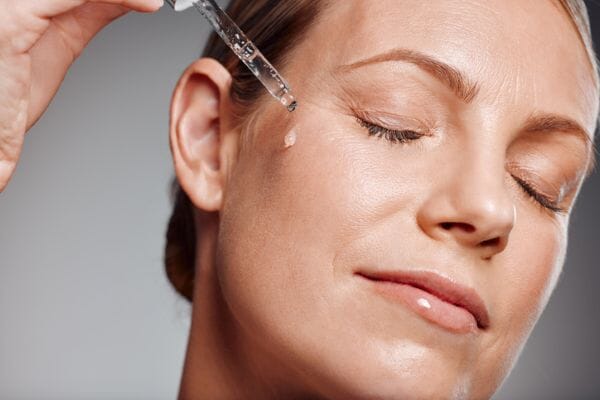
Try Kalme Skincare, a range of non-perfumed and chemical-free products containing targeted ingredients such as anti-redness and prebiotics for dealing with the cyclical symptoms of rosacea.
2. Avoid frequently changing products
Skin prone to rosacea tends to be hypersensitive and takes time to adjust to and accept new skincare ingredients. If a skincare regime gives positive results, stick to it and don’t switch it or try mixing it with other products.
3. Use a daily SPF
UV rays are one of the most common triggers for rosacea flares as UV damage causes localised inflammation of the skin. Therefore, if you suffer from rosacea, always use a daily SPF in all weathers.

Physical mineral SPF’s such as zinc oxide are preferable to chemical filter SPF’s for rosacea-prone skin as they are less reactive and remain more stable when exposed to UV light.
4. Don’t wash skin with water
Temperature changes can trigger rosacea flares and so washing the face with water, either warm or cold, can cause a sudden temperature change.

Instead use water-free cleansers with moisturising ingredients to clean skin and remove cosmetics.
5. Select perfume-free skincare
Perfumes in skincare can commonly cause minor reactions in sensitive skin and so are best avoided. Any skincare recommended for skin prone to rosacea, a reactive skin condition, should not contain perfumes.



